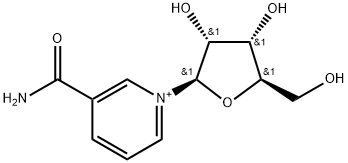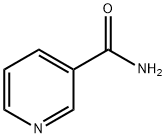3-Carbamoyl-1-((2R,3R,4S,5R)-3,4-dihydroxy-5-(hydroxymethyl)tetrahydrofuran-2-yl)pyridin-1-ium , 95% , 1341-23-7
CAS NO.:1341-23-7
Empirical Formula: C11H15N2O5+
Molecular Weight: 255.25
MDL number:
EINECS: 1308068-626-2
| Pack Size | Price | Stock | Quantity |
| 1g | RMB33.60 | In Stock |
|
| 5g | RMB116.00 | In Stock |
|
| 25g | RMB468.00 | In Stock |
|
| 100g | RMB1543.20 | In Stock |
|
| others | Enquire |
PRODUCT Properties
| storage temp. | Store at -20°C |
| solubility | Water: Soluble |
| form | A low-melting semi-solid |
| InChI | InChI=1/C11H14N2O5/c12-10(17)6-2-1-3-13(4-6)11-9(16)8(15)7(5-14)18-11/h1-4,7-9,11,14-16H,5H2,(H-,12,17)/p+1/t7-,8-,9-,11-/s3 |
| InChIKey | JLEBZPBDRKPWTD-XULPMDEONA-O |
| SMILES | O[C@@H]1[C@@H]([C@@H](CO)O[C@H]1[N+]1=CC=CC(C(=O)N)=C1)O |&1:1,2,3,7,r| |
Description and Uses
Nicotinamide Riboside (NR) is a next-generation vitamin B3 that has been found to be naturally-occurring in milk in trace amounts. The metabolism of NR is unique from that of other more commonly known forms of vitamin B3 , nicotinamide and nicotinic acid. Specifically, NR has been shown in a pre-clinical study to be the most effective form of vitamin B3 at increasing nicotinamide adenine dinucleotide (NAD+)2 .
Nicotinic acid (also known as niacin) and nicotinamide (also known as niacinamide) were discovered in the 1930’s to be the factors that cured pellagra . Niacin is known to cause severe flushing . In 2004, nicotinamide riboside emerged as a newly discovered NAD+ precursor and does not bind to the receptor responsible for flushing.
NR has pre-clinically demonstrated that it is superior to both niacin and nicotinamide, both of which are standard forms of vitamin B3 commonly used in vitamin supplements and foods, at boosting NAD+2 . This is due to the fact that NR is not reliant upon a conversion step requiring the enzyme “NAMPT” , see Figure below. The activity level of NAMPT determines the amount of nicotinamide that is converted into NAD+ , which is why this particular step in the process is often referred to as the “rate limiting step”. As normal aging occurs, the activity of NAMPT is thought to decrease. NR can be used by the cell to make NAD+ without this enzymatic step.
NAD+ synthesis from nicotinic acid, nicotinamide, and nicotinamide riboside
Nicotinamide Riboside can be used in biological study of gene circadian reprogramming transcriptome in liver identified metabolic pathways of aging in mouse. It also increases NAD+ in the cerebral cortex and reduces cognitive deterioration in a transgenic mouse model of Alzheimer’s disease.
Safety
| Symbol(GHS) |  GHS07 |
| Signal word | Warning |
| Hazard statements | H302-H315-H319-H335 |
| Precautionary statements | P261-P264-P270-P271-P280-P301+P312-P330-P302+P352-P321-P304+P340-P305+P351+P338-P332+P313-P362+P364-P337+P313-P403+P233-P405-P501 |


